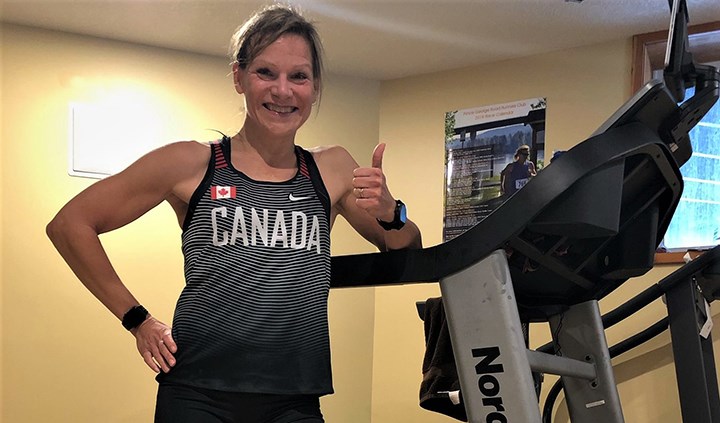Jacqui Pettersen has been chasing it for years.
A couple of weeks ago she finally tracked it down - her first sub-three-hour marathon time.
Pettersen has traveled the world, running the biggest races in London, Berlin, Boston New York and Chicago along with tens of thousands of other competitors. Her times have steadily been dropping, but COVID forced a change of plan.
The pandemic scuttled her first crack at the Tokyo Marathon in March and postponed her trip to London, England in October for the age-group world championships. So Pettersen had to go looking for an event she could race and found one – the Scotiabank Toronto Waterfront Virtual Marathon.
On Oct. 31, Pettersen got on her treadmill in the basement of her Prince George home and ran 42.2-kilometres in two hours 56 minutes, shredding five minutes off her previous best time, set a year ago at the Berlin Marathon.
“It was a goal that I guess you could say was a long time coming,” said Pettersen, who ran her first marathon in 1995.
“I actually didn’t think it was in the realm of possibilities about two years ago, but when I changed my training plan and started to knock off time I began to the think, ‘I’m getting closer to the three-hour mark, I wonder if I can actually get under it?’
“So when I was that close in Berlin last year, I was 3:01, then it was, ‘ must do this one way or another before I get too old and can’t do it anymore.’”
Participants in the Toronto Waterfront virtual event have from Oct. 1-Nov. 21 to complete the race and each runner submits a screen shot photo of their GPS tracking or running app, which shows their time and distance ran. As of Monday, Pettersen’s posted time of 2:10:00 was the fastest of all the female solo marathoners.
Running on a treadmill for nearly three hours is a grind at the best of times and Pettersen says it’s as much a mental challenge as it is a physical strain.
“There’s a lot of self-talk involved, I found a lot of time negative thoughts would creep in and I’d have to counter them with positive thoughts to keep myself going,” she said. “I’d be thinking, ‘this pace is so hard, how will I maintain it for 42 kilometres?
“But I’ve done a significant amount of my training on the treadmill over the last few years. I was forced to jump on the treadmill during the fires two summers in a row when I was training for Berlin, and in the winter, with the inclement weather, when I was training for Tokyo. I’d say 95 per cent of my training was done on the treadmill.
“I love it as a training tool, It’s a way to have complete control over your pace. If you don’t feel like going a certain pace one day, you dial in the speed and you know what you have to do, otherwise you’re going to fly off the end of the treadmill.”
Pettersen, who turns 50 next June, is well-versed in the benefits of training and the time it takes to accomplish goals. It took 18 years of postsecondary school studies for the College Heights Secondary School grad to achieve her professional standing as a cognitive behaviour neurologist and associate professor in the Northern Medical Program at UNBC.Marathoners usually peak in the 30s but Pettersen seems to be getting faster with age, and she’s not alone.
“Lately, in any of the big marathon events, there seems to be a trend with women especially doing very well in marathons at an older age,” she said. “There seems to be several other women in the 40s who seem to be getting better and better. It’s been inspiring to watch some of these other women.”
Pettersen learned of the cancelation of this year’s Tokyo Marathon - the only event of the big six world marathons she’s never raced – a week before the race, right when she was starting to taper off her training. She and her family still made the trip but the infection rates were spiking in Japan at the time and they unable to visit other parts of the country.
Her Berlin time qualified her for the age group world championships and in May it was postponed until Oct. 4. With no end in sight for the pandemic that race went virtual, except for the elite runners. Pettersen planned to do the virtual run but got sick that week but she was feeling better on the day of the race. So she went to the outdoor track at Lac des Bois Elementary School and ran 105.5 laps to complete the marathon distance.
“It wasn’t a great time for me, but I did it,” Pettersen said. “Part of the motivation to do the treadmill race at the end of October was that I hadn’t met my goal for the London Marathon and I just wanted another opportunity, given all the training I’d put in.
“I was really pleased to finally break three hours. It’s not an in-person event but it does give me confidence I’ll be able to do it at an in-person event the next time one happens.”
Depending on when international travel resumes, Pettersen is registered for the world age group championships in London in Oct. 3, 2021 and has the choice of racing the Tokyo Marathon on Oct. 17, 2021 or in March 2022. For Tokyo, she’s targeting 2022.



